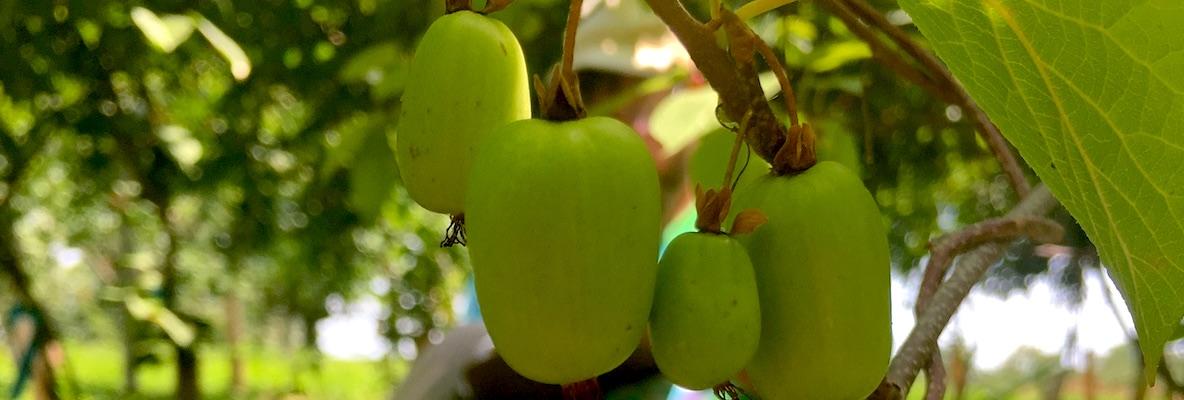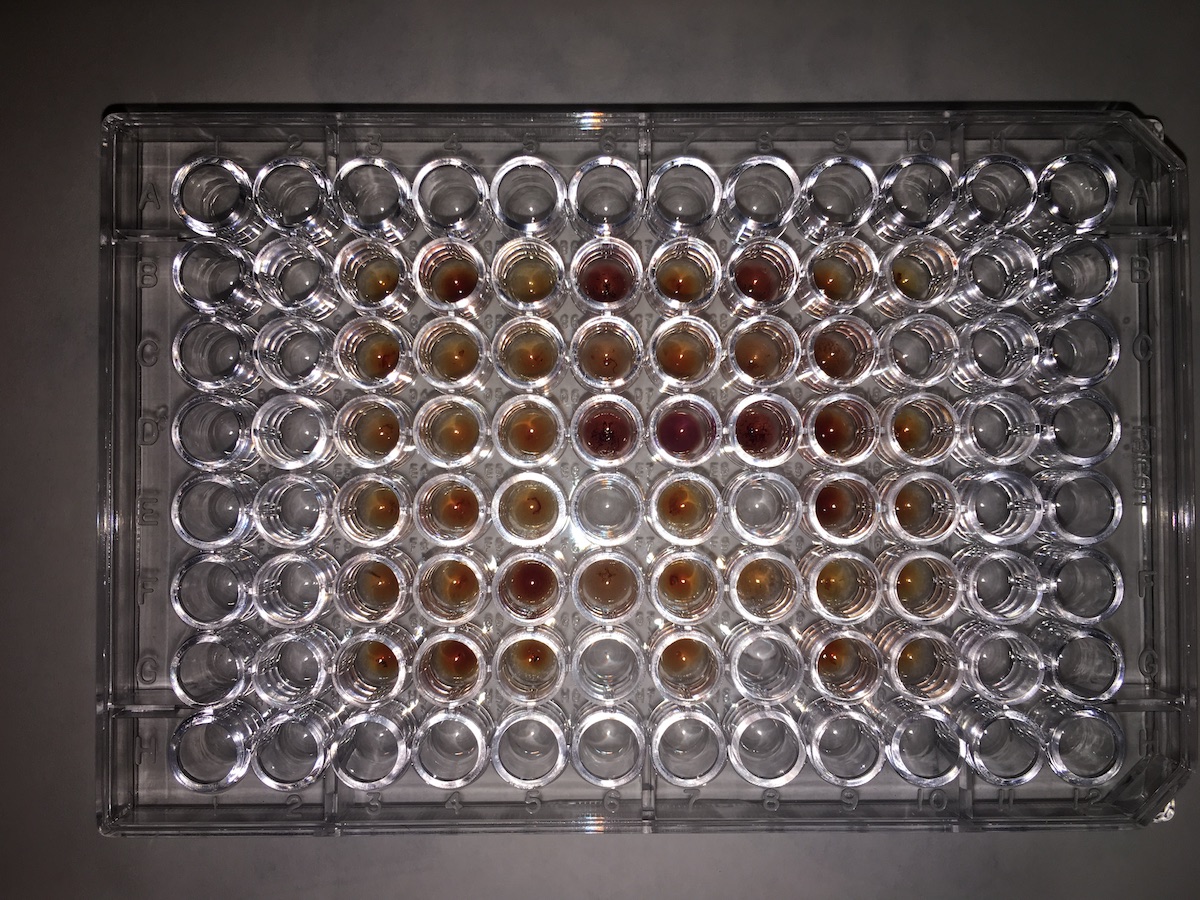The common kiwifruit we know from New Zealand is great tasting and has lots of nutritional value. Sometimes they aren’t the most convenient to eat though, with their furry skin and double-golf-ball size. Fortunately, kiwifruit has a group of cousins in the same genus, Actinidia, that are known as kiwiberries. Kiwiberries consist of a few different species that are much smaller - about the size of a large grape - and best of all, they are hairless. Kiwiberries also have great nutritional value and are perfectly sized for popping into your mouth for a quick snack.
Kiwiberries, however, can contain some chemical components that are slightly allergenic for some people. As you might guess, The University of Minnesota fruit breeding program is working on that. We have been evaluating kiwiberry cultivars for desirable chemical constituents like flavor and nutritional value, along with undesirable constituents including those allergens. We are developing protocols to detect various molecules so we can identify the allergenic components and work to minimize them as we develop new cultivars using traditional plant breeding methods. Of course we aren't only looking at the fruit when developing new cultivars. We also take into account horticultural characteristics such as cold hardiness and pest resistance. That way, we'll introduce high quality cultivars that can be grown successfully in Minnesota's climate.
Kiwiberry basics
A kiwiberry can refer to several species in the Actinidia genus. The two most common species being researched at the University of Minnesota, A. arguta and A. kolomikta, originated from Northern Asia including areas in Japan, the Korean Peninsula, Northern China, and Southern Russia. The berries are spherical to cylindrical between 4cm and 10cm in size. Kiwiberries’ green flesh reminds an eater of kiwifruit but the skin has none of that inconvenient fuzz. The smooth skin of a kiwiberry can come in shades of green and yellow with stripes from white to dark green. A consumer can look for kiwiberries in the grocery store in the fall months usually for only about two weeks. U of M fruit breeders are working to develop cultivars that can reliably survive Minnesota winters so we can have access to more of this fruit. Since the berries can be harvested up to two weeks before ripening, local production would allow for the kiwiberry crop to be available longer at our local markets.
What am I eating when I eat a kiwiberry?
Lots of things! Fruit are very complicated when you look at them through a scientific lens. Some compounds most consumers might be familiar with include vitamin C, oxalic acid, proteins, enzymes, sugars, and sugar alcohols along with some carbohydrates and structural molecules. These components also play important roles in the fruit’s growth and development, but as consumers we tend to focus on how they contribute to flavor and nutritional value.
Vitamin C
Because the human body does not create its own vitamin C, it is a necessary dietary supplement.1 Vitamin C, or ascorbic acid, is involved in several biological processes including the synthesis of collagen used in wound healing and as an antioxidant in the body.2,3 A deficiency in vitamin C can result in a disease called scurvy or scorbutus, which can be treated and avoided by regularly consuming enough vitamin C.4 Researchers at the University of Minnesota have developed a method to quantify the vitamin C in kiwiberries, and have found that our varieties are very high in this healthy vitamin.
Oxalic Acid
Oxalic acid, or oxalate, is a naturally occurring small molecule that can act as a weak acid. Different kiwiberry varieties produce different amounts of oxalic acid. Sometimes oxalates can bind to calcium or other small minerals which results in an insoluble form of the molecule.5 This means the oxalate can form crystals and precipitate out of a solution. In humans, this can result in calcium oxalate crystals forming in the bladder otherwise known as kidney stones.6 Fruit breeders are working to minimize the oxalic acid produced by the varieties of kiwiberries that will be made available to the public. But until then, don't worry. Drinking lots of water with any food high in oxalates can mitigate the risks too.
Sugars
Kiwiberries contain sugars, making them a sweet and enjoyable treat. Just like other fruit, kiwiberries are a great source of natural sugars making them a tempting snack for younger palates and sweet toothed adults. Common sugars found in the kiwiberry are glucose, fructose, and sucrose. These naturally occurring sugars are healthy, just as in any other sweet fruit, unless consumed in excessive quantities.
Enzymes and Allergens
Enzymes are large molecules in cells that perform or catalyze chemical processes for the function of a cell. In kiwiberries a common enzyme of interest is actinidin. This enzyme is a cysteine protease that can break apart certain proteins, which can be used in the food industry as meat tenderizer or to aid digestion.7 For some consumers, eating a kiwiberry after a large meal can help settle the stomach, but for others this enzyme can cause irritation in their mouths.8 Because this enzyme can cause an allergic response, we are working to reduce the amount of actinidin in ripe kiwiberries that will be sold at stores. It is important to be aware that actinidin is similar to the enzymes in kiwifruit, papayas, and pineapples that can cause mouth irritation. Someone allergic to any of these fruits should be aware that they may have the same allergy to kiwiberries.
The outlook for kiwiberries
Kiwiberries are a delicious fruit that have a lot of chemistry happening inside. They are a great source of vitamin C but consumers should be aware of the allergens and remember to drink lots of water with their snack if kidney stones are a concern.
So where can you buy kiwiberries? You might find some seasonally available kiwiberries now, but most of them are imported from New Zealand and only show up at specialty stores. Someday soon, fruit breeders at the University of Minnesota hope to introduce new cold tolerant cultivars which we anticipate will boost local production. Keep your eyes peeled!
This research is supported by the Minnesota Department of Agriculture, the University of Minnesota Fruit Breeding Program, and the University of Minnesota Department of Horticultural Science. Special thanks to Seth Wannemuehler, Dr. James Luby, Dr. Adrian Hegeman, Jack Tillman, and Bob Guthrie.
Images
All images by Abigail Diering.
References
1. Office of Dietary Supplements - Vitamin C https://ods.od.nih.gov/factsheets/vitaminc-consumer/ (accessed Jul 8, 2018).
2. Frei, B.; England, L.; Ames, B. N. Ascorbate Is an Outstanding Antioxidant in Human Blood Plasma. Proc. Natl. Acad. Sci. U. S. A. 1989, 86 (16), 6377–6381.
3. Carr, A. C.; Frei, B. Toward a New Recommended Dietary Allowance for Vitamin C Based on Antioxidant and Health Effects in Humans. Am. J. Clin. Nutr. 1999, 69 (6), 1086–1107.
4. Scurvy | Genetic and Rare Diseases Information Center (GARD) – an NCATS Program https://rarediseases.info.nih.gov/diseases/10406/scurvy (accessed Jul 8, 2018).
5. G.P. Savage. Effect of Cooking on the Soluble and Insoluble Oxalate Content of Some New Zealand Foods - ScienceDirect https://www.sciencedirect.com/science/article/pii/S0889157500908792 (accessed Aug 3, 2018).
6. A to Z Health Guide. Calcium Oxalate Stones https://www.kidney.org/atoz/content/calcium-oxalate-stone (accessed Aug 3, 2018).
7. Martin, H. Quantification of Functional Actinidin in Whole Kiwifruit Extract Using the Selective Cysteine Proteinase Inhibitor E-64. J. Food Nutr. Res. J. Food Nutr. Res. 2017, 4 (4), 243–250.
8. Pastorello, E. A.; Conti, A.; Pravettoni, V.; Farioli, L.; Rivolta, F.; Ansaloni, R.; Ispano, M.; Incorvaia, C.; Giuffrida, M. G.; Ortolani, C. Identification of Actinidin as the Major Allergen of Kiwi Fruit. J. Allergy Clin. Immunol. 1998, 101 (4), 531–537.
9. Varughese, K. I.; Su, Y.; Cromwell, D.; Hasnain, S.; Xuong, N. H. Crystal Structure of an Actinidin-E-64 Complex. Biochemistry (Mosc.) 1992, 31, 5172–5176.







